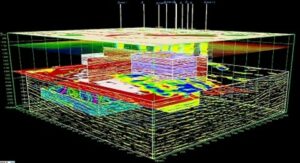Special topics
 There are a number of ways of locating oil and gas reservoirs such as surveys based on the earth’s gravitational pull, magnetic field or electrical resistance; but the most important way of locating oil and gas reservoirs is by seismic surveys.
There are a number of ways of locating oil and gas reservoirs such as surveys based on the earth’s gravitational pull, magnetic field or electrical resistance; but the most important way of locating oil and gas reservoirs is by seismic surveys.
How do Oil Companies find oil and gas?
For over one hundred years and other companies have been looking for oil and gas in every corner of the world. In the past, wells were drilled into the Earth where people had a ‘feeling’ that there could be oil- perhaps where oil seeps had been found nearby. Often, large folds of rocks, called ‘anticlines’, seen at the earth’s surface, were drilled in the hope that oil or gas may be trapped in the folds down below. Now there are more scientific approaches, such as using a combination of the geology of an area, gravity and magnetic surveys, seismic surveys and remote sensing techniques like aerial photography and satellite imagery from outer space. These methods all help to point to areas where oil and gas may be found. However, seismic surveys are the most important modern technique for locating new oil and gas deposits. A seismic survey uses sound waves which are created just beneath the land surface or near the surface of the sea. The waves travel down through layers of rocks and bounce back like echoes. By using computers, geologists and geophysicists can build up an accurate picture of what is under the ground or seabed, and then figure out where oil and gas might be found. Seismic pictures can be in 2D (a vertical slice through the layered earth), or in 3D (a whole cube of information about the layers inside of the earth).
When the petroleum geologists are exploring a possible location, seismic surveys help them to pinpoint whether the underground rock types and structures are right for there to be oil or natural gas present. Then an exploration well is drilled to judge whether the area contains any oil or gas and is worth exploring further. If so, other team members are brought in to shoot more detailed seismic surveys, drill more wells, and eventually to design the oil platforms and pipelines required to extract and transport the oil and gas to be processed.
A seismic survey relies on sound waves which are created at the land surface or near the surface of the sea. The sound waves are usually made by specially built trucks that thump and vibrate the ground, or ships towing ‘guns’ powered by compressed air. The sound waves travel down through layers of rocks and bounce back like echoes. The sound waves are recorded by arrays of special microphones, called ‘geophones’ on land, and ‘hydrophones’ at sea. By using computers, geologists and geophysicists can analyze the sounds that are recorded, and use them to create an accurate picture of where oil and gas might be found.
In conclusion, the use of the seismic surveys including the 2D seismic surveys and the 3D seismic survey should be used in all exploration exercises due to the enormous benefit such as easy location of oil deposits making the exploration less time consuming.
By: DAVID ADUHENE TANOH www.reportingoilandgas.com